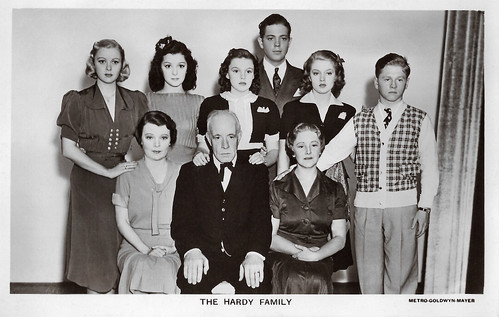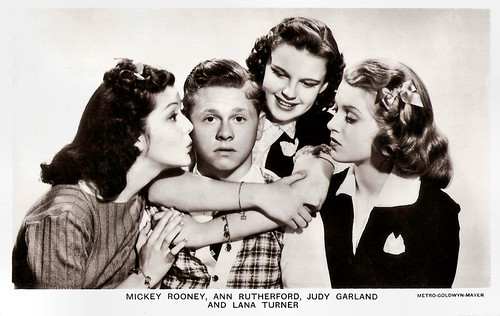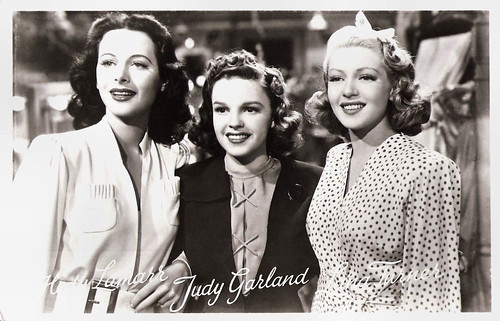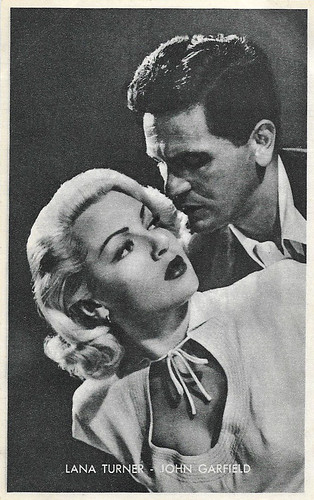Blonde and voluptuous Lana Turner (1921-1995) was one of the most glamorous superstars of Hollywood's golden era. In the mid-1940s, she was one of the highest-paid women in the United States, and one of MGM's biggest stars, with her films earning the studio over $50 million during her eighteen-year contract with them. Unfortunately, her tumultuous private life sometimes overshadowed her professional accomplishments.
![Lana Turner]()
Dutch postcard by J.S.A. (Uitg. J. Sleding N.V., Amsterdam). Photo: Metro Goldwyn Mayer (MGM).
![Lana Turner]()
French postcard by Editions P.I., Paris, offered by Victoria, Brussels, no. D 236. Photo: Eric Carpenter / Metro-Goldwyn-Mayer, 1950.
![Lana Turner]()
American postcard by Coral-Lee, Rancho Cordova, CA, no. CL/Personality # 107.
![Lana Turner]()
Italian postcard by CCM, no. 2. Photo: MGM.
![Lana Turner]()
Italian postcard, no. 347.
Lana Turner was born Julia Jean Mildred Francis Turner in Wallace, Idaho, in 1920 or 1921. Her parents were Mildred Frances (Cowan) and John Virgil Turner, a miner. Both were still in their teens when she was born. In 1929, her father was murdered and it was shortly thereafter her mother moved her and the family to California.
Turner's discovery is considered a show-business legend and part of Hollywood mythology. One version erroneously has her discovery occurring at Schwab's Pharmacy. By her own account, as a junior at Hollywood High School, Turner skipped a typing class and bought a Coca-Cola at the Top Hat Malt Shop located on the southeast corner of Sunset Boulevard and McCadden Place.
There she was spotted by William R. Wilkerson, publisher of The Hollywood Reporter. He asked her if she was interested in appearing in films, to which she responded: "I'll have to ask my mother first." With her mother's permission, Turner was referred by Wilkerson to the actor/comedian/talent agent Zeppo Marx.
In December 1936, Marx introduced Turner to film director Mervyn LeRoy, who signed her to a fifty-dollar weekly contract with Warner Bros. In 1937, 17-years-old Lana entered the film world, and made her debut in the crime drama They Won't Forget (Mervyn LeRoy, 1937). She attracted attention with her small role as a murder victim. After that followed parts in the historical comedy The Great Garrick (James Whale, 1937) and A Star is Born (William A. Wellman, 1937) with Janet Gaynor.
In 1938 she had another supportting part in Love Finds Andy Hardy (George B. Seitz, 1938) starring Mickey Rooney. The film made her known as 'The Sweater Girl'. (Some sources say otherwise). Her auburn hair was bleached for Idiot's Delight (Clarence Brown, 1939). She was withdrawn from the film, but the fact that she had become a blonde not only changed her screen image but gave her such an outgoing, swinging personality that Hollywood called her 'the Nightclub Queen'.
One of her first lead roles was in Dancing Co-Ed (S. Sylvan Simon, 1939), a vehicle for 28-year-old bandleader Artie Shaw. The two married, but their highly publicised marriage only lasted four months. Turner became a popular pin-up, especially with American soldiers fighting overseas, and her image appeared painted on the noses of U.S. fighter planes, bearing the nickname 'Tempest Turner'.
In 1941 she starred in the Western Honky Tonk (Jack Conway, 1941), her first major hit. It was the first of four films in which she would star opposite Clark Gable. She was now firmly entrenched in the film business. She had good roles in such films as the Film Noir Johnny Eager (Mervyn LeRoy, 1941), the musical Ziegfeld Girl (Robert Z. Leonard, 1941) with Hedy Lamarr and Judy Garland, the horror film Dr. Jekyll and Mr. Hyde (Victor Fleming, 1941), the romantic war drama Somewhere I'll Find You (Wesley Ruggles, 1942) with Gable again, and Week-End at the Waldorf (Robert Z. Leonard, 1945).
If her career was progressing smoothly, however, her private life was turning into a train wreck, keeping her in the news in a way no one would have wanted. Upon separating from Shaw, Turner married actor-turned-restaurateur Stephen Crane, but when his earlier divorce was declared invalid, a media frenzy followed. They remarried, but divorced in 1944. In the meanwhile their daughter Cheryl was born.
![Lana Turner in They Won't Forget (1937).]()
Italian postcard in the '100 Artisti del Cinema' series by Edizione Elah 'La Casa delle Caramelle', no. 30. Photo: Warner Bros. Photo: Warner Bros. Publicity still for They Won't Forget (Mervyn LeRoy, 1937). Vendetta is the Italian title for the film.
![Mickey Rooney in Love Finds Andy Hardy (1938)]()
British postcard in the Picturegoer Series, London, no. 1280. Photo: Metro-Goldwyn-Mayer. Publicity still for Love Finds Andy Hardy (George B. Seitz, 1938) with (back row) Cecilia Parker, Ann Rutherford, Judy Garland, Gene Reynolds, Lana Turner and (front row) Mary Howard, Lewis Stone, Fay Holden and Mickey Rooney.
![Mickey Rooney, Ann Rutherford, Judy Garland and Lana Turner in Love Finds Andy Hardy (1938)]()
British postcard in the Picturegoer Series, London, no. 1281. Photo: Metro-Goldwyn-Mayer. Publicity still for Love Finds Andy Hardy (George B. Seitz, 1938) with Mickey Rooney, Ann Rutherford, Judy Garland and Lana Turner.
![Hedy Lamarr, Judy Garland and Lana Turner in Ziegfeld Girl (1941)]()
Dutch postcard, no. 3114. Photo: MGM. Publicity still for Ziegfeld Girl (Robert Z. Leonard, Busby Berkeley, 1941) with Hedy Lamarr and Judy Garland.
![Lana Turner and John Garfield in The Postman Always Rings Twice (1946)]()
Belgian Collectors Card by Kwatta, Bois d'Haine, no. C. 173. Photo: Metro-Goldwyn-Mayer. Collection: Geoffrey Donaldson Institute. Publicity still for The Postman Always Rings Twice (Tay Garnett, 1946) with John Garfield.
Lana Turner's most sultry and effective turn to date was the femme fatale in the Film Noir The Postman Always Rings Twice (Tay Garnett, 1946). She portrayed Cora, a young and ambitious woman married to a stodgy, older owner of a roadside diner (Cecil Kellaway), who falls in love with a drifter (John Garfield) and their desire to be together motivates them to murder her husband.
The film, based on the debut novel of James Cain, was a tremendous success, and it made Turner one of Hollywood's brightest stars. Bosley Crowther, film critic of The New York Times, gave the film a positive review and lauded the acting and direction of the film: "Too much cannot be said for the principals. Mr. Garfield reflects to the life the crude and confused young hobo who stumbles aimlessly into a fatal trap. And Miss Turner is remarkably effective as the cheap and uncertain blonde who has a pathetic ambition to 'be somebody' and a pitiful notion that she can realize it through crime."
In August 1947, only moments after having completed filming of Cass Timberlane (George Sidney, 1947), Turner agreed to appear as the female lead in Homecoming (Mervyn LeRoy, 1948). In this World War II-set romantic drama, she was again paired with Clark Gable, portraying a female army lieutenant who falls in love an American surgeon (Gable). She was the studio's first choice for the role, but they were reluctant to offer her the part, considering her overbooked schedule. Homecoming was well-received by audiences, and Turner and Gable were nicknamed 'the team that generates steam'.
Turner was at the zenith of her film career, and was not only MGM's most popular star, but also one of the 10 highest-paid women in the United States, with annual earnings of $226,000 (equivalent to $2,400,000 in 2018). In late 1947, Turner was cast opposite Gene Kelly as Lady de Winter in The Three Musketeers (George Sidney, 1947), her first Technicolor film. Her popularity continued through the 1950s in dramas such as The Bad and the Beautiful (Vincente Minnelli, 1952) with Kirk Douglas.
After a sabbatical, Lana Turner returned with Peyton Place (Mark Robson, 1957). The adaptation of Grace Metalious' infamous best-seller about the steamy passions simmering beneath the surface of small-town life was hugely successful. Turner's performance won her an Academy Award nomination.
The following year she made international headlines when her lover, gangster Johnny Stampanato, was stabbed to death by her teenage daughter, Cheryl Crane. Crane was eventually acquitted on the grounds of justifiable homicide, but Turner's reputation took a severe beating.
Douglas Sirk's Imitation of Life (1959) was Turner's last major hit. Sirk's final melodrama has an engaging and emotional story with romance, ambition, friendship, love and rejection. The subplot of Turner's black housekeeper Annie (Juanita Moore) who is rejected by her light-skinned daughter (Susan Kohner), in a time when the colour of people was a watershed, is still heartbreaking. Imitation of Life was one of the biggest hits of the year, and the biggest of Turner's career: she owned 50% of the earnings of the picture.
Her final starring role in Madame X (David Lowell Rich, 1966) opposite Ricardo Montalban, earned her a David di Donatello Award for Best Foreign Actress. Her final film, Witches' Brew (Richard Shorr, Herbert L. Strock, 1980) with Teri Garr, a semi-comic remake of the horror classic Weird Woman (Reginald LeBorg, 1944), was shot in 1978 but not widely released until 1985.
In 1982, she published an autobiography, 'Lana: The Lady, the Legend, the Truth', and also began a stint as a semi-regular on the TV soap opera Falcon Crest (1982-1983). Her daughter, Cheryl Crane, also wrote a book about her life with her mother, her mother's 7 husbands and numerous boyfriends and living in Hollywood. 'Detour: A Hollywood Story' was published in 1988.
In 1992 Lana Turner was diagnosed with throat cancer. After spending the majority of her final decade in retirement, Lana Turner died in 1995, at the age of 74. She bequeathed her companion and housekeeper her entire trust estate, valued at almost $2 million, including her apartment in Century City and rights to all income producing assets. She changed the beneficiary of her trust estate in the last years of her life, from her daughter to her housekeeper, and instead left her daughter a cash bequest of only $50,000.
![Lana Turner]()
Belgian collectors card by Chocolaterie Clovis, Pepinster. Collection: Amit Benyovits.
![Lana Turner]()
French postcardby Editions P.I., Paris, no. 22 D. Photo: Metro Goldwyn Mayer (MGM), 1953.
![Lana Turner]()
Dutch postcard. Photo: MGM.
![Lana Turner]()
German postcard by ISV, no. D 16. Photo: Star Press.
![Lana Turner and Clark Gable in Homecoming (1948)]()
Belgian Collectors Card by Kwatta, Bois d'Haine, no. C. 168. Photo: Metro-Goldwyn-Mayer. Publicity still for Homecoming (Mervyn LeRoy, 1948) with Clark Gable.
![Lana Turner]()
Belgian collectors card by Kwatta, Bois d'Haine, no. C 209. Photo: Metro-Goldwyn-Mayer.
![Lana Turner]()
Belgian collectors card by Kwatta, Bois d'Haine, no. C 307. Photo: Metro-Goldwyn-Mayer. Publicity still for A Life of Her Own (George Cukor, 1950).
![Lana Turner]()
Belgian Collectors Card by Kwatta, Bois d'Haine. Photo: Metro-Goldwyn-Mayer. Collection: Geoffrey Donaldson Institute.
![Lana Turner]()
Belgian Collectors Card by Kwatta, Bois d'Haine. Photo: Metro-Goldwyn-Mayer. Collection: Geoffrey Donaldson Institute.
![Lana Turner in The Merry Widow (1952)]()
American postcard by Dexter Press, Pearl River, N.Y., no. 61952. Photo: Metro-Goldwyn-Mayer. Publicity still for The Merry Widow (Curtis Bernhardt, 1952).
![Lana Turner]()
French postcard by Editions du Globe, Paris, no. 408. Photo: Metro Goldwyn Mayer (MGM).
![Lana Turner]()
Italian postcard by B.F.F. Edit., no. 2983. Photo: Metro Goldwyn Mayer (MGM).
Source: Jason Ankeny (AllMovie), Wikipedia and IMDb.

Dutch postcard by J.S.A. (Uitg. J. Sleding N.V., Amsterdam). Photo: Metro Goldwyn Mayer (MGM).

French postcard by Editions P.I., Paris, offered by Victoria, Brussels, no. D 236. Photo: Eric Carpenter / Metro-Goldwyn-Mayer, 1950.

American postcard by Coral-Lee, Rancho Cordova, CA, no. CL/Personality # 107.

Italian postcard by CCM, no. 2. Photo: MGM.

Italian postcard, no. 347.
A show-business legend and part of Hollywood mythology
Lana Turner was born Julia Jean Mildred Francis Turner in Wallace, Idaho, in 1920 or 1921. Her parents were Mildred Frances (Cowan) and John Virgil Turner, a miner. Both were still in their teens when she was born. In 1929, her father was murdered and it was shortly thereafter her mother moved her and the family to California.
Turner's discovery is considered a show-business legend and part of Hollywood mythology. One version erroneously has her discovery occurring at Schwab's Pharmacy. By her own account, as a junior at Hollywood High School, Turner skipped a typing class and bought a Coca-Cola at the Top Hat Malt Shop located on the southeast corner of Sunset Boulevard and McCadden Place.
There she was spotted by William R. Wilkerson, publisher of The Hollywood Reporter. He asked her if she was interested in appearing in films, to which she responded: "I'll have to ask my mother first." With her mother's permission, Turner was referred by Wilkerson to the actor/comedian/talent agent Zeppo Marx.
In December 1936, Marx introduced Turner to film director Mervyn LeRoy, who signed her to a fifty-dollar weekly contract with Warner Bros. In 1937, 17-years-old Lana entered the film world, and made her debut in the crime drama They Won't Forget (Mervyn LeRoy, 1937). She attracted attention with her small role as a murder victim. After that followed parts in the historical comedy The Great Garrick (James Whale, 1937) and A Star is Born (William A. Wellman, 1937) with Janet Gaynor.
In 1938 she had another supportting part in Love Finds Andy Hardy (George B. Seitz, 1938) starring Mickey Rooney. The film made her known as 'The Sweater Girl'. (Some sources say otherwise). Her auburn hair was bleached for Idiot's Delight (Clarence Brown, 1939). She was withdrawn from the film, but the fact that she had become a blonde not only changed her screen image but gave her such an outgoing, swinging personality that Hollywood called her 'the Nightclub Queen'.
One of her first lead roles was in Dancing Co-Ed (S. Sylvan Simon, 1939), a vehicle for 28-year-old bandleader Artie Shaw. The two married, but their highly publicised marriage only lasted four months. Turner became a popular pin-up, especially with American soldiers fighting overseas, and her image appeared painted on the noses of U.S. fighter planes, bearing the nickname 'Tempest Turner'.
In 1941 she starred in the Western Honky Tonk (Jack Conway, 1941), her first major hit. It was the first of four films in which she would star opposite Clark Gable. She was now firmly entrenched in the film business. She had good roles in such films as the Film Noir Johnny Eager (Mervyn LeRoy, 1941), the musical Ziegfeld Girl (Robert Z. Leonard, 1941) with Hedy Lamarr and Judy Garland, the horror film Dr. Jekyll and Mr. Hyde (Victor Fleming, 1941), the romantic war drama Somewhere I'll Find You (Wesley Ruggles, 1942) with Gable again, and Week-End at the Waldorf (Robert Z. Leonard, 1945).
If her career was progressing smoothly, however, her private life was turning into a train wreck, keeping her in the news in a way no one would have wanted. Upon separating from Shaw, Turner married actor-turned-restaurateur Stephen Crane, but when his earlier divorce was declared invalid, a media frenzy followed. They remarried, but divorced in 1944. In the meanwhile their daughter Cheryl was born.

Italian postcard in the '100 Artisti del Cinema' series by Edizione Elah 'La Casa delle Caramelle', no. 30. Photo: Warner Bros. Photo: Warner Bros. Publicity still for They Won't Forget (Mervyn LeRoy, 1937). Vendetta is the Italian title for the film.

British postcard in the Picturegoer Series, London, no. 1280. Photo: Metro-Goldwyn-Mayer. Publicity still for Love Finds Andy Hardy (George B. Seitz, 1938) with (back row) Cecilia Parker, Ann Rutherford, Judy Garland, Gene Reynolds, Lana Turner and (front row) Mary Howard, Lewis Stone, Fay Holden and Mickey Rooney.

British postcard in the Picturegoer Series, London, no. 1281. Photo: Metro-Goldwyn-Mayer. Publicity still for Love Finds Andy Hardy (George B. Seitz, 1938) with Mickey Rooney, Ann Rutherford, Judy Garland and Lana Turner.

Dutch postcard, no. 3114. Photo: MGM. Publicity still for Ziegfeld Girl (Robert Z. Leonard, Busby Berkeley, 1941) with Hedy Lamarr and Judy Garland.

Belgian Collectors Card by Kwatta, Bois d'Haine, no. C. 173. Photo: Metro-Goldwyn-Mayer. Collection: Geoffrey Donaldson Institute. Publicity still for The Postman Always Rings Twice (Tay Garnett, 1946) with John Garfield.
The team that generates steam
Lana Turner's most sultry and effective turn to date was the femme fatale in the Film Noir The Postman Always Rings Twice (Tay Garnett, 1946). She portrayed Cora, a young and ambitious woman married to a stodgy, older owner of a roadside diner (Cecil Kellaway), who falls in love with a drifter (John Garfield) and their desire to be together motivates them to murder her husband.
The film, based on the debut novel of James Cain, was a tremendous success, and it made Turner one of Hollywood's brightest stars. Bosley Crowther, film critic of The New York Times, gave the film a positive review and lauded the acting and direction of the film: "Too much cannot be said for the principals. Mr. Garfield reflects to the life the crude and confused young hobo who stumbles aimlessly into a fatal trap. And Miss Turner is remarkably effective as the cheap and uncertain blonde who has a pathetic ambition to 'be somebody' and a pitiful notion that she can realize it through crime."
In August 1947, only moments after having completed filming of Cass Timberlane (George Sidney, 1947), Turner agreed to appear as the female lead in Homecoming (Mervyn LeRoy, 1948). In this World War II-set romantic drama, she was again paired with Clark Gable, portraying a female army lieutenant who falls in love an American surgeon (Gable). She was the studio's first choice for the role, but they were reluctant to offer her the part, considering her overbooked schedule. Homecoming was well-received by audiences, and Turner and Gable were nicknamed 'the team that generates steam'.
Turner was at the zenith of her film career, and was not only MGM's most popular star, but also one of the 10 highest-paid women in the United States, with annual earnings of $226,000 (equivalent to $2,400,000 in 2018). In late 1947, Turner was cast opposite Gene Kelly as Lady de Winter in The Three Musketeers (George Sidney, 1947), her first Technicolor film. Her popularity continued through the 1950s in dramas such as The Bad and the Beautiful (Vincente Minnelli, 1952) with Kirk Douglas.
After a sabbatical, Lana Turner returned with Peyton Place (Mark Robson, 1957). The adaptation of Grace Metalious' infamous best-seller about the steamy passions simmering beneath the surface of small-town life was hugely successful. Turner's performance won her an Academy Award nomination.
The following year she made international headlines when her lover, gangster Johnny Stampanato, was stabbed to death by her teenage daughter, Cheryl Crane. Crane was eventually acquitted on the grounds of justifiable homicide, but Turner's reputation took a severe beating.
Douglas Sirk's Imitation of Life (1959) was Turner's last major hit. Sirk's final melodrama has an engaging and emotional story with romance, ambition, friendship, love and rejection. The subplot of Turner's black housekeeper Annie (Juanita Moore) who is rejected by her light-skinned daughter (Susan Kohner), in a time when the colour of people was a watershed, is still heartbreaking. Imitation of Life was one of the biggest hits of the year, and the biggest of Turner's career: she owned 50% of the earnings of the picture.
Her final starring role in Madame X (David Lowell Rich, 1966) opposite Ricardo Montalban, earned her a David di Donatello Award for Best Foreign Actress. Her final film, Witches' Brew (Richard Shorr, Herbert L. Strock, 1980) with Teri Garr, a semi-comic remake of the horror classic Weird Woman (Reginald LeBorg, 1944), was shot in 1978 but not widely released until 1985.
In 1982, she published an autobiography, 'Lana: The Lady, the Legend, the Truth', and also began a stint as a semi-regular on the TV soap opera Falcon Crest (1982-1983). Her daughter, Cheryl Crane, also wrote a book about her life with her mother, her mother's 7 husbands and numerous boyfriends and living in Hollywood. 'Detour: A Hollywood Story' was published in 1988.
In 1992 Lana Turner was diagnosed with throat cancer. After spending the majority of her final decade in retirement, Lana Turner died in 1995, at the age of 74. She bequeathed her companion and housekeeper her entire trust estate, valued at almost $2 million, including her apartment in Century City and rights to all income producing assets. She changed the beneficiary of her trust estate in the last years of her life, from her daughter to her housekeeper, and instead left her daughter a cash bequest of only $50,000.

Belgian collectors card by Chocolaterie Clovis, Pepinster. Collection: Amit Benyovits.

French postcardby Editions P.I., Paris, no. 22 D. Photo: Metro Goldwyn Mayer (MGM), 1953.

Dutch postcard. Photo: MGM.

German postcard by ISV, no. D 16. Photo: Star Press.

Belgian Collectors Card by Kwatta, Bois d'Haine, no. C. 168. Photo: Metro-Goldwyn-Mayer. Publicity still for Homecoming (Mervyn LeRoy, 1948) with Clark Gable.

Belgian collectors card by Kwatta, Bois d'Haine, no. C 209. Photo: Metro-Goldwyn-Mayer.

Belgian collectors card by Kwatta, Bois d'Haine, no. C 307. Photo: Metro-Goldwyn-Mayer. Publicity still for A Life of Her Own (George Cukor, 1950).

Belgian Collectors Card by Kwatta, Bois d'Haine. Photo: Metro-Goldwyn-Mayer. Collection: Geoffrey Donaldson Institute.

Belgian Collectors Card by Kwatta, Bois d'Haine. Photo: Metro-Goldwyn-Mayer. Collection: Geoffrey Donaldson Institute.

American postcard by Dexter Press, Pearl River, N.Y., no. 61952. Photo: Metro-Goldwyn-Mayer. Publicity still for The Merry Widow (Curtis Bernhardt, 1952).

French postcard by Editions du Globe, Paris, no. 408. Photo: Metro Goldwyn Mayer (MGM).

Italian postcard by B.F.F. Edit., no. 2983. Photo: Metro Goldwyn Mayer (MGM).
Source: Jason Ankeny (AllMovie), Wikipedia and IMDb.